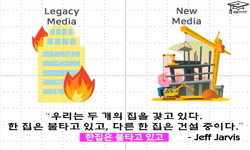This study investigates the desirable relationship between ‘character’ and ‘image’ by looking at the debate that occurred in China in 2000’s with the concept of ‘image reading age’. This paper mainly deals with the debates on ‘commerci...
http://chineseinput.net/에서 pinyin(병음)방식으로 중국어를 변환할 수 있습니다.
변환된 중국어를 복사하여 사용하시면 됩니다.
- 中文 을 입력하시려면 zhongwen을 입력하시고 space를누르시면됩니다.
- 北京 을 입력하시려면 beijing을 입력하시고 space를 누르시면 됩니다.
https://www.riss.kr/link?id=A103504790
- 저자
- 발행기관
- 학술지명
- 권호사항
-
발행연도
2017
-
작성언어
Korean
- 주제어
-
등재정보
KCI등재
-
자료형태
학술저널
- 발행기관 URL
-
수록면
117-136(20쪽)
-
KCI 피인용횟수
0
- 제공처
-
0
상세조회 -
0
다운로드
부가정보
다국어 초록 (Multilingual Abstract)
This study investigates the desirable relationship between ‘character’ and ‘image’ by looking at the debate that occurred in China in 2000’s with the concept of ‘image reading age’. This paper mainly deals with the debates on ‘commerciality’ and ‘popularity’ of ‘image reading age’ and the history of ‘image’ as media among the discussions in China. As critics of the concept of ‘image reading age’ pointed out, it was a concept that clearly emerged from commercial intentions and flowed into the academic realm. However, ‘image reading age’ is an era that exists extensively, and it is necessary to be seriously treated academically to establish a new relationship between ‘character’ and ‘image’. I think it is necessary to criticize the nature of the global capitalist ideology implied by today’s ‘cultural commercialization’ trend, but it is not right to put the stigma of commercialism solely on the ‘image’ media.
On the other hand, the attempt to grasp the media of ‘image’ historically helps to understand the nature of ‘image reading age’. This study examined the related debates generated in China through Vilém Flusser’s media theory. Vilém Flusser saw today’s ‘technical image’ as an abstraction of text of characters. Accordingly, since the text is already embedded in the ‘technical image’, it has different characteristics from the images of the pre-modern era. In addition, Vilém Flusser builds a theory that criticizes modernist performancism and efficiencism ideology by associating ‘technical image’ with ‘play’. This theory of Vilém Flusser helps to recognize that the relationship between letters and images is not unequal, but a relationship that requires harmony.
목차 (Table of Contents)
- 1. 들어가는 말 : ‘이미지 읽기 시대’ 개념의 등장과 그 문화 상황
- 2. 상업화 · 대중화 전략으로서의 ‘이미지 읽기’에 관한 논의
- 3. ‘이미지’ 미디어의 역사적 함의와 ‘문자-이미지’의 관계 설정
- 4. 나오는 말
- 參考文獻
- 1. 들어가는 말 : ‘이미지 읽기 시대’ 개념의 등장과 그 문화 상황
- 2. 상업화 · 대중화 전략으로서의 ‘이미지 읽기’에 관한 논의
- 3. ‘이미지’ 미디어의 역사적 함의와 ‘문자-이미지’의 관계 설정
- 4. 나오는 말
- 參考文獻
- Abstract
참고문헌 (Reference)
1 왕후이, "죽은 불 다시 살아나" 삼인 2004
2 빌렘 플루서, "사진의 철학을 위하여" 커뮤니케이션북스 1999
3 노르베르트 볼츠, "미디어란 무엇인가" 한울 2011
4 박민호, "개혁개방 이후 중국의 문학위기담론 연구" 한국외국어대학교 2016
5 周毅, "读图时代?" (5) : 1999
6 杨小彦, "话说读图时代―李陀、刘禾专访" (1) : 2001
7 张春, "论20世纪80年代以来文学出版观念的变迁" 2012
8 孙晓燕, "解读“读图时代”" (3) : 2004
9 李静, "影视小说 : “读图时代”的文学“宠儿”" (4) : 2007
10 梁振华, "媒介迁徙:通途或迷津" (2) : 2009
1 왕후이, "죽은 불 다시 살아나" 삼인 2004
2 빌렘 플루서, "사진의 철학을 위하여" 커뮤니케이션북스 1999
3 노르베르트 볼츠, "미디어란 무엇인가" 한울 2011
4 박민호, "개혁개방 이후 중국의 문학위기담론 연구" 한국외국어대학교 2016
5 周毅, "读图时代?" (5) : 1999
6 杨小彦, "话说读图时代―李陀、刘禾专访" (1) : 2001
7 张春, "论20世纪80年代以来文学出版观念的变迁" 2012
8 孙晓燕, "解读“读图时代”" (3) : 2004
9 李静, "影视小说 : “读图时代”的文学“宠儿”" (4) : 2007
10 梁振华, "媒介迁徙:通途或迷津" (2) : 2009
11 吴昊, "图像與文学关係的历史考察―兼谈文学在“图像时代”的生存策略" (3) : 2007
12 赖大仁, "图像化扩张與“文学性”坚守" (2) : 2005
13 曾军, "传媒时代的学术生产―“读图时代”批判" (3) : 2008
14 陈平原, "从左图右史到图文互动" (3) : 2004
15 周宪, "“读图时代”的图文“战争”" (6) : 2005
16 王卓慈, "“读图时代”对文学的另一种诉求" (5) : 2004
17 심혜련, "20세기의 매체철학" 그린비 2015
동일학술지(권/호) 다른 논문
-
- 한국중어중문학회
- 鄒志遠(Zou, Zhi Yuan)
- 2017
- KCI등재
-
- 한국중어중문학회
- 강필임(Kang, Pil yim)
- 2017
- KCI등재
-
- 한국중어중문학회
- 고영란(Ko, Young Ran)
- 2017
- KCI등재
-
- 한국중어중문학회
- 李圭甲(Lee, Kyoo Kap)
- 2017
- KCI등재
분석정보
인용정보 인용지수 설명보기
학술지 이력
| 연월일 | 이력구분 | 이력상세 | 등재구분 |
|---|---|---|---|
| 2027 | 평가예정 | 재인증평가 신청대상 (재인증) | |
| 2021-01-01 | 평가 | 등재학술지 유지 (재인증) |  |
| 2018-01-01 | 평가 | 등재학술지 유지 (등재유지) |  |
| 2015-01-01 | 평가 | 등재학술지 유지 (등재유지) |  |
| 2013-05-21 | 학회명변경 | 한글명 : 변화없음 -> 한국중어중문학회영문명 : Korea Association of Chinese Language And Literature -> 미등록 |  |
| 2013-05-21 | 학회명변경 | 한글명 : 한국중어중문학회 -> 변화없음영문명 : The Chinese Language And Literature Society Of Korea -> Korea Association of Chinese Language And Literature |  |
| 2013-05-21 | 학술지명변경 | 외국어명 : The Journal of Chinese Language and Literature -> Korea Journal of Chinese Language and Literature |  |
| 2011-01-01 | 평가 | 등재학술지 유지 (등재유지) |  |
| 2009-01-01 | 평가 | 등재학술지 유지 (등재유지) |  |
| 2007-01-01 | 평가 | 등재학술지 유지 (등재유지) |  |
| 2005-01-01 | 평가 | 등재학술지 유지 (등재유지) |  |
| 2002-01-01 | 평가 | 등재학술지 선정 (등재후보2차) |  |
| 1999-01-01 | 평가 | 등재후보학술지 선정 (신규평가) |  |
학술지 인용정보
| 기준연도 | WOS-KCI 통합IF(2년) | KCIF(2년) | KCIF(3년) |
|---|---|---|---|
| 2016 | 0.32 | 0.32 | 0.26 |
| KCIF(4년) | KCIF(5년) | 중심성지수(3년) | 즉시성지수 |
| 0.26 | 0.22 | 0.575 | 0.12 |





 DBpia
DBpia






